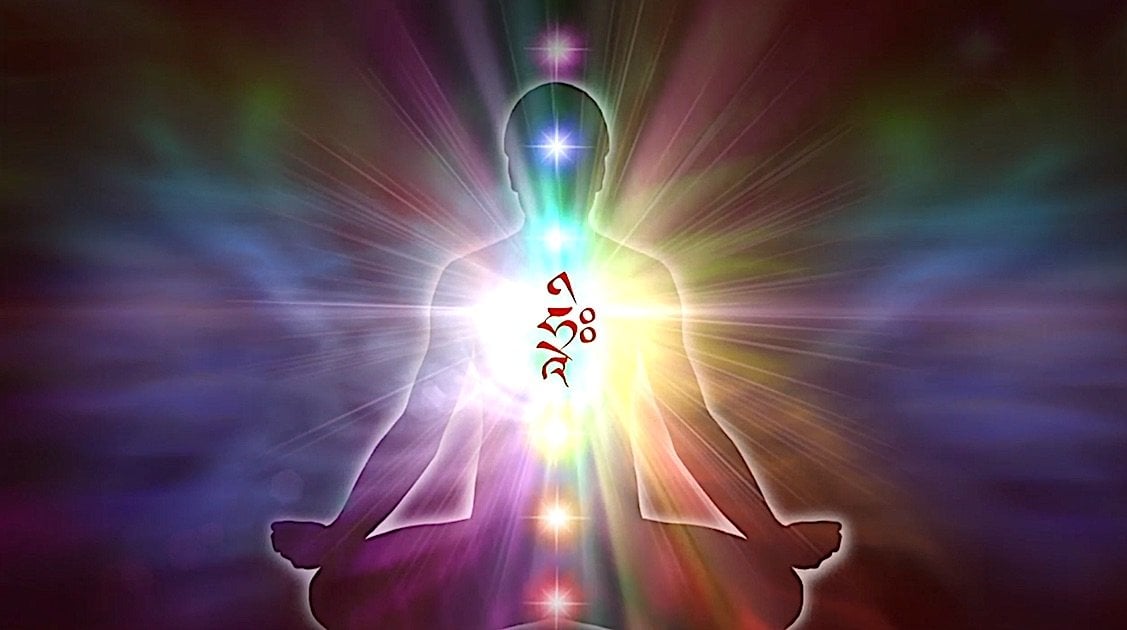The Six Yogas of Naropa (Sankirt. Saḍdharma, "Naro's six doctrines" or "six teachings") are a set of advanced Tibetan Buddhist tantric practices compiled by the Indian mahasiddhas Tilopa and Nāropa (1016–1100 CE) and passed on to the Tibetan translator-yogi Marpa Lotsawa (c. 1012).
Another name for the six Dharmas is "the oral instruction transmission for achieving liberation in the bardo," or "the Bardo Trang-dol system." Bardo here refers to the three bardos of waking, sleeping, and dying. They are also referred to as "the path of means" (thabs lam) in Kagyu literature. They are also sometimes called the Six Yogas of Nāropa (though not in the traditional literature, which never uses the term ṣaḍaṅga-yoga or sbyor-drug).
The six yogas are a collection of tantric Buddhist completion stage practices drawn from the Buddhist tantras. They are intended to lead to Buddhahood in an accelerated manner. They traditionally require tantric initiation and personal instruction through working with a tantric guru, as well as various preliminary practices. The six yogas work with the subtle body, particularly through the generation of inner heat (tummo) energy.The six yogas are a main practice of the Kagyu school (and were originally unique to that school), and key Kagyu figures such as Milarepa, Gampopa, Phagmo Drugpa, and Jigten Sumgon taught and practiced these yogas. They taught in the Gelugpa lineage and were introduced by Je Tsongkhapa, who received the lineage through his Kagyu teachers.
Overview of Preliminary Practices
For example, Milarepa is quoted by Tsongkhapa as stating that the first one establishes the basics, "such as refuge in the three jewels and the two aspects of Bodhicitta." Tsongkhapa also quotes poems by Milarepa, which show that he held that one should first practice contemplating the nature of karma, observing the faults of sensuality and samsara, as well as meditate on kindness and Bodhicitta.
In all schools of Tibetan Buddhism, there are various preliminary practices drawn from the common Mahayana that are prescribed to students before beginning the practice of completion stage yoga (such as taking refuge, Bodhicitta aspiration, guru yoga, deity yoga, and dedication of merit). The details of this depend on the lineage, school, and individual teacher.
The six yogas of Naropa are meant to be a comprehensive and holistic collection of the completion stage practices of Indian Buddhist tantra. In Kagyu and Gelug, initiation or empowerment into at least one Anuttarayogatantra system (generally Cakrasaṃvara and/or Vajrayogini/Vajravarāhi Tantras) and practice of its Generation Stage are the bases for practice of the six yogas.The six yogas though variously classified (from just two to up to ten dharmas), the most widely used list of six yogas in the work of the Kagyu school figure Gampopa conforms to the following list: * Tummo: the yoga of inner heat (or mystic heat). In Tibetan Buddhism, Tummo is the fierce goddess of heat and passion. Tummo is found in the Mahasiddha Krishnacarya and the Hevajra Tantra texts.
Tummo is also a Tantric practice for inner heat, developed around the concept of the female deity. It is found in the Six Yogas of Naropa, Lamdre, Kalachakra, and the Anuyoga teachings of Vajrayana. The purpose of tummo is to gain control over body processes during the completion stage of the Anuyoga or Anuttarayoga Tantra (the highest yoga tantra').
The practice begins by visualising the body's energy channels, winds, drops, and chakras. Inner heat, generated through specific breath-holding exercises, helps vital winds enter the central channel, leading to blissful experiences. The practice also involves focusing on seed syllables at the chakras and combining them with meditation on emptiness. Over time, practitioners aim to master this process, achieving heightened states of clarity, inner heat, and bliss.
Scientific studies have explored the effects of tummo, demonstrating notable increases in body temperature, metabolism, and thermal power output among expert meditators. While the practice's effects on body temperature have been investigated, its primary purpose within Tibetan Buddhism remains focused on spiritual development, combining visualization, breath, and meditation to harness the inner fire and achieve profound states of enlightenment.
* Footnote
For those who have received the empowerment of this Tantric practise, you are reminded not to intentionally or unintentionally disclose the mantra to the public or anyone who may not have the empowerment or permission to practise, and disclosing the mantra intentionally or unintentionally is a form of breaking your Tantric Samaya vows to the lineage masters and Dharma protectors.
Please consult your Guru or a qualified lineage master for Vajrayana practise! Should a devotee even want to start studying and contemplating the Vajrayana practise, then it is truly necessary to first have completed the preliminaries and to be certain that Bodhicitta has arisen and developed in one’s mind.
Vajrayana features countless skillful and powerful methods that, if practised in the proper way, can make the process of accumulation and purification incredibly swift and direct. It is absolutely necessary to have pure motivation and to know that Vajrayana practise is not carried out to increase one’s own ego, power, or self-interest.
Donations for our Buddhist research and development
Do you earnestly cherish our devoted work? Assuming this is the case, we are delighted that you are finding our blog useful and valuable. Would you consider making a donation for our Buddhist research and development?
We need your help to secure the future of scholarly interaction with Buddhism. Since our very first publication of Dharma works and activities in 2008, we have been effortlessly providing free distribution of Dharma posts and articles throughout the previous 14 years. We have exceptionally constrained support and do not receive subsidies or funding from people in general.
Please help us develop our Dharma activities that will not only benefit you but all Dharma readers on the planet. Please consider showing your support. Your generosity will certainly help us enhance our work and accomplish more for a better and brighter future.
Thank you for reading. May you find peace and great bliss. With your support, it helps to spread the Buddha’s precious teachings and turn the Dharma wheels in the world.
Aspiration For Bodhichitta
For those in whom the precious Bodhichitta has not arisen
May it arise and not decrease.
But increase further and further.
Dedication of Merit
By this merit, may we then obtain omniscience then.
Having defeated the enemies wrongdoings
May we liberate migratory from the ocean of existence.
With its stormy waves of birth, old age, sickness, and death.
*Note
I do not own or infringe any copyright on the picture(s).
Picture(s) courtesy and credit to the rightful distributors and/or studios
The picture(s) are intended for editorial use only.




























